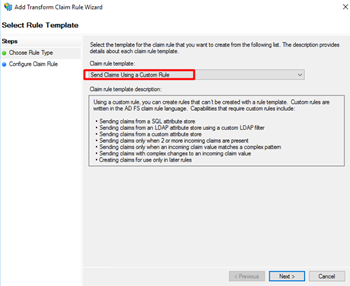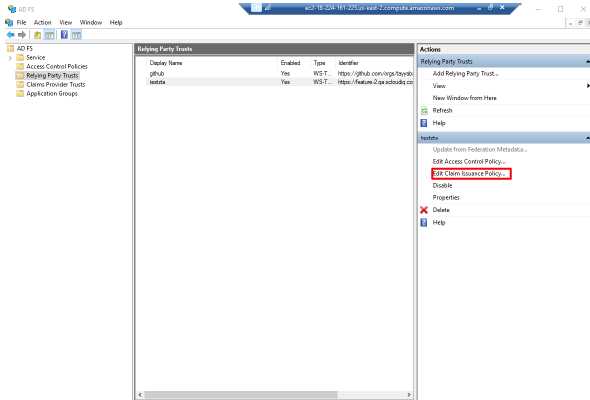SAML-based SSO in Microsoft Server 2016 AD
Before you begin
About this task
Use this procedure to set up SAML-based SSO in Microsoft Server 2016 AD.
Procedure
- Go to your MS 2016 AD Server Manager.
- To create a relying party trust as part of configuring partner organizations, select Relying Party Trust and follow the instructions.
- To create a rule to send Lightweight Directory Access Protocol (LDAP) attributes as claims, select Create a Rule to Send LDAP Attributes as Claims and follow the instructions.
-
Follow these steps to create claim rules for Zero Trust Access (ZTA)
applications as a service provider.

Note
Add claim rules for ZTA as a service provider in Identity Provider (IdP) windows server 2016.- Go to ADFS Manager > Relying party trust add claim issuance policy > Add Rule.
-
From the Select Rule Template screen, in the Claim Rule
Template field, select Send Claim Using a Custom
Rule.


- Select Next.
-
Add this attribute rule as a custom rule: c:[Type ==
"http://schemas.xmlsoap.org/ws/2005/05/identity/claims/upn"] =>
issue(Type =
"http://schemas.xmlsoap.org/ws/2005/05/identity/claims/nameidentifier",
Issuer = c.Issuer, OriginalIssuer = c.OriginalIssuer, Value = c.Value,
ValueType = c.ValueType,
Properties["http://schemas.xmlsoap.org/ws/2005/05/identity/claimproperties/format"]
= "urn:oasis:names:tc:SAML:2.0:nameid-format:unspecified");

Note
If you applied the rule successfully, you will receive a successful status. -
Select ADFS > Service > Relying Party Trust > Edit Claim Insurance Policy.


- Select Add Rule > OK.
- From the Select Rule Template screen, in the Claim Rule Template field, select Send LDAP Attributes as Claims.
- Select Next.
-
Add a Rule.

Note
If you applied the rule successfully, you will receive a successful status. - Select OK > Close.
